by Bill Murray
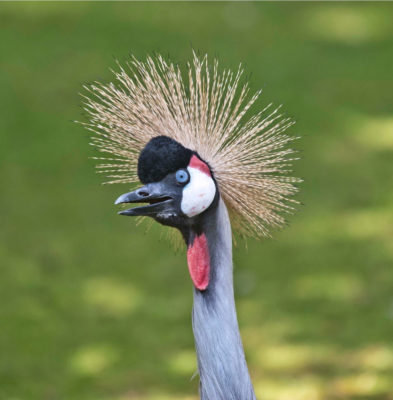 Cogito Ergo Sum? Welcome to the party. There’s a lot more going on out there than we sometimes think: Cephalopods memorize, learn, invent, and play; indeed, they acquire information about the outside world while still in their eggs. • The small, flowering thale, or mouse-ear cress, can detect the vibrations caused by caterpillars munching on it and so release oils and chemicals to repel the insects. • The fruit fly Drosophila shows evidence of depression if it gets too hot. • Plants discern the difference between blue and red light, and use this information to know which direction to grow. They differentiate between the dimming scarlet light of sunset and the brightening orange light of sunrise, to determine when to flower. • Pigs comprehend symbolic language, plan for the future and discern the intentions of others. They bore easily and show a clear preference for novelty. • When researchers arranged oat flakes in the geographical pattern of cities around Tokyo, slime mold constructed nutrient channeling tubes that closely mimicked Tokyo’s metro rail. • Some plants can feel you touching them. • Cuvier’s beaked whales can dive to 10,000 feet and stay there, at tremendous pressure, for up to two hours. In 2020 scientists recorded a Cuvier’s beaked whale staying below the water for 3 hours 42 minutes. • The nearly blind star-nosed mole, the world’s fastest eater, can find and gobble down an insect or worm in a quarter of a second. It hunts by bopping its star against the soil as quickly as possible, touching 10 or 12 different places in a single second. • The 10 centimeter long cleaner wrasse, a reef fish, has joined great apes, bottlenose dolphins, killer whales, Eurasian magpies and a particular Asian elephant in exhibiting self-awareness.
Cogito Ergo Sum? Welcome to the party. There’s a lot more going on out there than we sometimes think: Cephalopods memorize, learn, invent, and play; indeed, they acquire information about the outside world while still in their eggs. • The small, flowering thale, or mouse-ear cress, can detect the vibrations caused by caterpillars munching on it and so release oils and chemicals to repel the insects. • The fruit fly Drosophila shows evidence of depression if it gets too hot. • Plants discern the difference between blue and red light, and use this information to know which direction to grow. They differentiate between the dimming scarlet light of sunset and the brightening orange light of sunrise, to determine when to flower. • Pigs comprehend symbolic language, plan for the future and discern the intentions of others. They bore easily and show a clear preference for novelty. • When researchers arranged oat flakes in the geographical pattern of cities around Tokyo, slime mold constructed nutrient channeling tubes that closely mimicked Tokyo’s metro rail. • Some plants can feel you touching them. • Cuvier’s beaked whales can dive to 10,000 feet and stay there, at tremendous pressure, for up to two hours. In 2020 scientists recorded a Cuvier’s beaked whale staying below the water for 3 hours 42 minutes. • The nearly blind star-nosed mole, the world’s fastest eater, can find and gobble down an insect or worm in a quarter of a second. It hunts by bopping its star against the soil as quickly as possible, touching 10 or 12 different places in a single second. • The 10 centimeter long cleaner wrasse, a reef fish, has joined great apes, bottlenose dolphins, killer whales, Eurasian magpies and a particular Asian elephant in exhibiting self-awareness.
• Some sauropod dinosaurs had necks stretching up to 11 metres (36 feet) long. • A monkey community on Kōjima island near the southern tip of Japan washes sweet potatoes in the sea, where they acquire a salty taste. This behavior is passed from one generation of monkeys to the next. This is cultural behavior. • By the age of five a chimpanzee named Ai learned eleven colors and that Arabic numerals can represent numbers. Ai can, for example, assign the label “Red/Pencil/5” when five red pencils are shown to her. • Near the Indian city of Kannauj certain plants secrete fatty acids into the soil to slow the growth of nearby plants, reducing competition when water is scarce. • 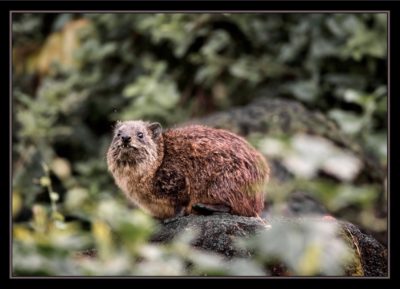 Hyraxes can stare into the sun, have tiny tusks, armpit nipples, and excrete a weird pee/poop substance in their group latrines used by perfumers and also as a folk remedy for epilepsy. • The oldest known wild bird on earth is a female Laysan Albatross named Wisdom. Scientists put a leg band on Wisdom in 1956, when she was already at least five years old. That puts her age at at least 70 years. In late 2020, Wisdom returned to her breeding grounds on Midway Island and successfully hatched and raised a chick, her 40th known child. • The tube worm takes advice from bacteria. It spends its earliest days drifting among plankton but selects where to metamorphose into its adult form by monitoring chemical signals released by bacteria. That suggests the bacteria are getting something in return. Speculation: the bacteria are helping to assure new habitat, which the growing body of the tubeworm will provide. • Giraffes’ eyes are among the largest of terrestrial mammals’, they can see in color and over great distances frontally, and their peripheral vision is so wide-angled they can essentially see behind themselves. Their mouths are like a set of human hands, with thick, prehensile lips and 18-inch-long, prehensile tongues which can together grasp a leafy branch and then deftly pluck away the leaves while avoiding intervening thorns. • The shaggy ink cap mushroom is capable of erupting through asphalt and lifting heavy paving stones overnight, although they are not themselves a tough material. No one knows how they do it. •
Hyraxes can stare into the sun, have tiny tusks, armpit nipples, and excrete a weird pee/poop substance in their group latrines used by perfumers and also as a folk remedy for epilepsy. • The oldest known wild bird on earth is a female Laysan Albatross named Wisdom. Scientists put a leg band on Wisdom in 1956, when she was already at least five years old. That puts her age at at least 70 years. In late 2020, Wisdom returned to her breeding grounds on Midway Island and successfully hatched and raised a chick, her 40th known child. • The tube worm takes advice from bacteria. It spends its earliest days drifting among plankton but selects where to metamorphose into its adult form by monitoring chemical signals released by bacteria. That suggests the bacteria are getting something in return. Speculation: the bacteria are helping to assure new habitat, which the growing body of the tubeworm will provide. • Giraffes’ eyes are among the largest of terrestrial mammals’, they can see in color and over great distances frontally, and their peripheral vision is so wide-angled they can essentially see behind themselves. Their mouths are like a set of human hands, with thick, prehensile lips and 18-inch-long, prehensile tongues which can together grasp a leafy branch and then deftly pluck away the leaves while avoiding intervening thorns. • The shaggy ink cap mushroom is capable of erupting through asphalt and lifting heavy paving stones overnight, although they are not themselves a tough material. No one knows how they do it. • 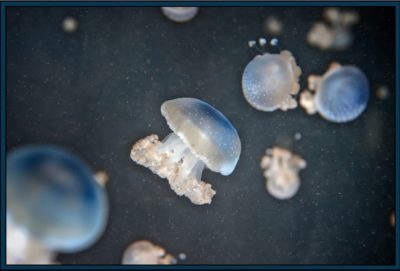 Some fungi species are able to harness radioactivity as a source of energy, similar to how plants use sunlight to grow. • The bar-tailed godwit migrates more than 7,000 miles annually between New Zealand and Alaska. • Birds may dodge storms by listening to infrasounds, low-frequency sounds inaudible to humans. Golden-winged warblers in the central and southeastern United States flew up to 9,300 miles in 2014 to evade an outbreak of tornadoes that killed 35 people and caused more than $1 billion in damage. The birds fled at least 24 hours before any foul weather hit, leaving scientists to deduce they had heard the storm system from more than 250 miles away. • Sub-Antarctic crested caracaras are rumored to spread wildfires by dropping burning sticks in dry grass and feasting on the ensuing stream of animal refugees. • Chimpanzees use medicinal plants. They consume fruits with antimicrobial properties; sometimes they combine them with other substances to reduce the toxicity. They eat flowers with antibiotic properties or leaves with antiparasitic ones, which act as laxatives or even induce uterine contractions. They also tear off bark and lick the resin to kill internal worms. • The peacock mantis shrimp’s limbs are so light and tough that scientists study them in the hope of creating new protective materials for human use. The shrimp uses them to stun or crack open prey, dig burrows, defend itself from predators, and fight against other shrimp. Its hammering is incredibly rapid, precise, and brutal: a speed of 100 kilometers per hour. The motion is among the fastest in the natural world — as if the little beast were firing bullets with a force of impact thousands of times its body weight. The attack occurs so rapidly, it’s invisible to the human eye. • One male oceanic dolphin was seen carrying a dead calf, accompanied by two female dolphins off the coast of Hawaii. No one knows whether the male killed the calf, which was thought to be the infant of the younger female. But by holding the body, he ensured the females stayed with him. • Puffins have two distinct phases of their lives: four months on land to breed, with the rest of the year spent out at sea. • Many young elephants who’d watched their mothers and relatives being killed went on to exhibit symptoms similar to post-traumatic stress disorder. • Many fish see four major colours; humans only see three. Some see polarised light, some see ultraviolet. Some, such as flounders, move their eyes independently, processing two image fields. •
Some fungi species are able to harness radioactivity as a source of energy, similar to how plants use sunlight to grow. • The bar-tailed godwit migrates more than 7,000 miles annually between New Zealand and Alaska. • Birds may dodge storms by listening to infrasounds, low-frequency sounds inaudible to humans. Golden-winged warblers in the central and southeastern United States flew up to 9,300 miles in 2014 to evade an outbreak of tornadoes that killed 35 people and caused more than $1 billion in damage. The birds fled at least 24 hours before any foul weather hit, leaving scientists to deduce they had heard the storm system from more than 250 miles away. • Sub-Antarctic crested caracaras are rumored to spread wildfires by dropping burning sticks in dry grass and feasting on the ensuing stream of animal refugees. • Chimpanzees use medicinal plants. They consume fruits with antimicrobial properties; sometimes they combine them with other substances to reduce the toxicity. They eat flowers with antibiotic properties or leaves with antiparasitic ones, which act as laxatives or even induce uterine contractions. They also tear off bark and lick the resin to kill internal worms. • The peacock mantis shrimp’s limbs are so light and tough that scientists study them in the hope of creating new protective materials for human use. The shrimp uses them to stun or crack open prey, dig burrows, defend itself from predators, and fight against other shrimp. Its hammering is incredibly rapid, precise, and brutal: a speed of 100 kilometers per hour. The motion is among the fastest in the natural world — as if the little beast were firing bullets with a force of impact thousands of times its body weight. The attack occurs so rapidly, it’s invisible to the human eye. • One male oceanic dolphin was seen carrying a dead calf, accompanied by two female dolphins off the coast of Hawaii. No one knows whether the male killed the calf, which was thought to be the infant of the younger female. But by holding the body, he ensured the females stayed with him. • Puffins have two distinct phases of their lives: four months on land to breed, with the rest of the year spent out at sea. • Many young elephants who’d watched their mothers and relatives being killed went on to exhibit symptoms similar to post-traumatic stress disorder. • Many fish see four major colours; humans only see three. Some see polarised light, some see ultraviolet. Some, such as flounders, move their eyes independently, processing two image fields. • 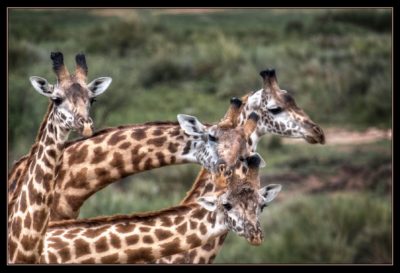 Bees can add and subtract. They understand nothing — that is, the concept of nothing. • Boasting a wingspan of around five feet and the ability to fly at speeds surpassing Usain Bolt in his prime, the black vulture Coragyps atratus can consume 140g of Brazilian household waste a day. • A group of zebras is collectively called a dazzle. • The genus of jumping spiders called Portia prefers to hunt other spiders, employing a clever trick. Females build nests in curled-up dead leaves suspended in air by silk attached to rocks or vegetation. Courting males crawl down silk suspension ropes, stand on top of the nest and shake it in a specific way, luring the female into an ambush. • Nearly every insect species has at least one species of parasitoid wasp that specializes in eating other insects alive. “They don’t just kill them, they want to keep them alive for as long as possible.” • Sea urchins, insects, spiders, crabs, snails, octopuses, fish, birds and mammals, among others, use tools. • Kites and falcons in the outback pick up burning sticks from bush fires, carry these smoking embers in their beaks to areas of dry grass and drop them, starting new fires, triggering frenzied evacuations by small animals – which are promptly snatched from above by the waiting raptors. Indigenous Australians start fires in order to flush out game. Which came first? • Some flowers tailor their petal shape, color, texture or nectar’s scent or flavor to attract a single pollinating species. • In Japan, one crow population uses traffic to crack open walnuts: The crows drop a nut in front of cars at intersections, and when the light turns red, they swoop in to scoop up the exposed flesh. • The female tsetse fly gestates her young internally, one at a time, and gives birth to them live. When each extravagantly pampered offspring pulls free of her uterus after nine days, mother and child are pretty much the same size. “It’s the equivalent of giving birth to an 18-year-old.” • Huge, burly, and equipped with a venomous sting, robber flies occasionally catch and kill hummingbirds. • Flies enjoy sex. Some male fruit flies were paired with females that were receptive to sex, while others were paired with females that rejected sexual advances. Both groups of males were then given access to a solution laced with alcohol and another lacking it. The sexually frustrated males consumed more alcohol than their sexually satisfied compatriots. • The tiny Toxeus magnus jumping spider, also known as the black ant mimicking jumper, looks like an ant, walks like an ant and even waves its front legs in the air like a pair of antennas. Females secrete a milk-like fluid to feed their offspring, which contains about four times as much protein as cow’s milk, prompting scientists to reconsider what it means to be a mammal. • The Antarctic blackfin icefish thrives in the Southern Ocean at temperatures just above seawater’s freezing point with no scales, blood as clear as water and bones so thin, you can see its brain through its skull. • In the mountains of Central America, the Alston’s singing mouse produces arias of loud chirps that can last as long as 16 seconds, and each mouse produces its own distinctive song. •
Bees can add and subtract. They understand nothing — that is, the concept of nothing. • Boasting a wingspan of around five feet and the ability to fly at speeds surpassing Usain Bolt in his prime, the black vulture Coragyps atratus can consume 140g of Brazilian household waste a day. • A group of zebras is collectively called a dazzle. • The genus of jumping spiders called Portia prefers to hunt other spiders, employing a clever trick. Females build nests in curled-up dead leaves suspended in air by silk attached to rocks or vegetation. Courting males crawl down silk suspension ropes, stand on top of the nest and shake it in a specific way, luring the female into an ambush. • Nearly every insect species has at least one species of parasitoid wasp that specializes in eating other insects alive. “They don’t just kill them, they want to keep them alive for as long as possible.” • Sea urchins, insects, spiders, crabs, snails, octopuses, fish, birds and mammals, among others, use tools. • Kites and falcons in the outback pick up burning sticks from bush fires, carry these smoking embers in their beaks to areas of dry grass and drop them, starting new fires, triggering frenzied evacuations by small animals – which are promptly snatched from above by the waiting raptors. Indigenous Australians start fires in order to flush out game. Which came first? • Some flowers tailor their petal shape, color, texture or nectar’s scent or flavor to attract a single pollinating species. • In Japan, one crow population uses traffic to crack open walnuts: The crows drop a nut in front of cars at intersections, and when the light turns red, they swoop in to scoop up the exposed flesh. • The female tsetse fly gestates her young internally, one at a time, and gives birth to them live. When each extravagantly pampered offspring pulls free of her uterus after nine days, mother and child are pretty much the same size. “It’s the equivalent of giving birth to an 18-year-old.” • Huge, burly, and equipped with a venomous sting, robber flies occasionally catch and kill hummingbirds. • Flies enjoy sex. Some male fruit flies were paired with females that were receptive to sex, while others were paired with females that rejected sexual advances. Both groups of males were then given access to a solution laced with alcohol and another lacking it. The sexually frustrated males consumed more alcohol than their sexually satisfied compatriots. • The tiny Toxeus magnus jumping spider, also known as the black ant mimicking jumper, looks like an ant, walks like an ant and even waves its front legs in the air like a pair of antennas. Females secrete a milk-like fluid to feed their offspring, which contains about four times as much protein as cow’s milk, prompting scientists to reconsider what it means to be a mammal. • The Antarctic blackfin icefish thrives in the Southern Ocean at temperatures just above seawater’s freezing point with no scales, blood as clear as water and bones so thin, you can see its brain through its skull. • In the mountains of Central America, the Alston’s singing mouse produces arias of loud chirps that can last as long as 16 seconds, and each mouse produces its own distinctive song. • 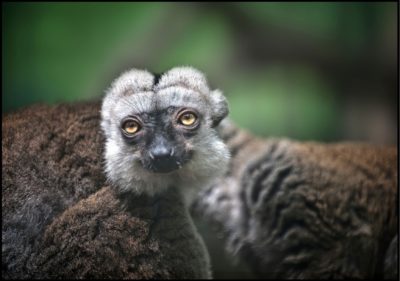 The flower Impatiens pallida, among others, devotes a greater share of resources to growing leaves than roots when put with strangers – a tactic apparently geared towards competing for sunlight, an imperative that is diminished when growing next to siblings. • The marine bacterium Vibrio fischeri can distinguish when it is alone or in a group. It produces light through bioluminescence, similar to fireflies. If these bacteria are alone, they make no light. But when a group grows to a certain number, all of them produce light simultaneously. • To maintain its stealth, a bioluminescent anglerfish in the genus Oneirodes reflects as little as 0.044 percent of the light it encounters. The rest gets lost in a labyrinth of light-swallowing pigments until it effectively disappears. • Gobies, a type of fish, seem to remember complicated routes for almost 40 days. Several species, especially guppies, can recognise other individual fish, evidence of complex social engagement. • Chickadees produce alarm calls when they detect a potential predator to warn their fellow chickadees using their namesake “chick-a-dee” alarm call. The number of “dee” notes at the end of this alarm call indicates the danger level of a predator. “Chick-a-dee-dee” with only two “dee” notes may indicate a rather harmless great gray owl. When chickadees see a pygmy owl, they increase the number of “dee” notes and call “chick-a-dee-dee-dee-dee.” The number of sounds serves as an active anti-predation strategy. • Prairie dogs use their twittering alarm calls to describe approaching humans in detail, including information about their size, the color of their hair and clothes, and any objects they might be carrying.
The flower Impatiens pallida, among others, devotes a greater share of resources to growing leaves than roots when put with strangers – a tactic apparently geared towards competing for sunlight, an imperative that is diminished when growing next to siblings. • The marine bacterium Vibrio fischeri can distinguish when it is alone or in a group. It produces light through bioluminescence, similar to fireflies. If these bacteria are alone, they make no light. But when a group grows to a certain number, all of them produce light simultaneously. • To maintain its stealth, a bioluminescent anglerfish in the genus Oneirodes reflects as little as 0.044 percent of the light it encounters. The rest gets lost in a labyrinth of light-swallowing pigments until it effectively disappears. • Gobies, a type of fish, seem to remember complicated routes for almost 40 days. Several species, especially guppies, can recognise other individual fish, evidence of complex social engagement. • Chickadees produce alarm calls when they detect a potential predator to warn their fellow chickadees using their namesake “chick-a-dee” alarm call. The number of “dee” notes at the end of this alarm call indicates the danger level of a predator. “Chick-a-dee-dee” with only two “dee” notes may indicate a rather harmless great gray owl. When chickadees see a pygmy owl, they increase the number of “dee” notes and call “chick-a-dee-dee-dee-dee.” The number of sounds serves as an active anti-predation strategy. • Prairie dogs use their twittering alarm calls to describe approaching humans in detail, including information about their size, the color of their hair and clothes, and any objects they might be carrying. 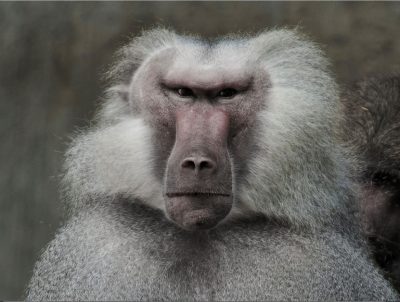 The intraspecies conversations of octopuses, bees, and many birds follow a recognizable grammatical structure. Dolphins have unique names for one another, as do certain species of parrots, monkeys, and bats. • Chaser the border collie could identify and retrieve more than a thousand different toys by name and understand elements of English grammar. • Plants fight back. When caterpillars graze European maize, for example, the plants emit the volatile β-caryophyllene, which attracts parasitic wasps. The wasps lay their eggs inside the caterpillars, slowing their feeding and eventually, when the eggs hatch a few weeks later, killing them. • Some mushrooms can hunt. When food becomes scarce, some fungi build traps consisting of sticky loops or poisonous droplets, and with special substances, they lure nematodes into these traps. • When the male Great Argus pheasant runs into a possible mate, he clears a six-yard stage on the forest floor, picking up leaves, twigs and roots with his little white beak, finally beating his wings to blow away the debris. He struts around theatrically, pecking at the clear stage. Then he twirls out his wings, transforming himself into a dazzlingly large, intricately patterned circle, and starts vibrating, shaking and shimmering for up to 15 seconds before resuming his old form and returning to his routine, pecking the ground. •
The intraspecies conversations of octopuses, bees, and many birds follow a recognizable grammatical structure. Dolphins have unique names for one another, as do certain species of parrots, monkeys, and bats. • Chaser the border collie could identify and retrieve more than a thousand different toys by name and understand elements of English grammar. • Plants fight back. When caterpillars graze European maize, for example, the plants emit the volatile β-caryophyllene, which attracts parasitic wasps. The wasps lay their eggs inside the caterpillars, slowing their feeding and eventually, when the eggs hatch a few weeks later, killing them. • Some mushrooms can hunt. When food becomes scarce, some fungi build traps consisting of sticky loops or poisonous droplets, and with special substances, they lure nematodes into these traps. • When the male Great Argus pheasant runs into a possible mate, he clears a six-yard stage on the forest floor, picking up leaves, twigs and roots with his little white beak, finally beating his wings to blow away the debris. He struts around theatrically, pecking at the clear stage. Then he twirls out his wings, transforming himself into a dazzlingly large, intricately patterned circle, and starts vibrating, shaking and shimmering for up to 15 seconds before resuming his old form and returning to his routine, pecking the ground. • 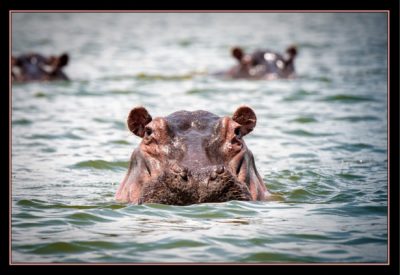 There have been several instances of an animal of one species helping an animal of a different species. For example, a hippopotamus was recorded lifting up a duckling that was unsuccessfully trying to get out of a pond, a bear rescued a crow from drowning and a cat attacked a dog that was trying to maul a toddler. • Spiders can fly, sort of, by electrostatic repulsion. They climb to an exposed point, raise their abdomens to the sky, extrude strands of silk, and float away. This is called ballooning. Ballooning spiders operate within the planet’s electric field. When their silk leaves their bodies, it typically picks up a negative charge. This repels the similar negative charges on the surfaces on which the spiders sit, creating enough force to lift them into the air. Spiders have been found 2.5 miles up in the air, and 1,000 miles out to sea. • The African crested rat chews on the bark of the poison arrow tree, then spits the masticated chunks all over its own hairs. It’s the only mammal we know of that uses toxins from a plant to make itself venomous. • The wings of Chinese tasar moths have scales that function like acoustic tiles. They absorb the sonar waves of predatory bats, making it very difficult for the bats to detect the moths with echolocation. • The Greenland shark, the eqalussuaq in Greenlandic, is the longest-living vertebrate on earth. Two hundred year-old eqalussuaqs are common, and some have been alive more than twice as long. A few still alive were probably born before Shakespeare, before the invention of telescopes or newspapers. Their nostrils aren’t needed for breathing (they have gills) but are used for smelling. They can smell small prey up to a mile away.
There have been several instances of an animal of one species helping an animal of a different species. For example, a hippopotamus was recorded lifting up a duckling that was unsuccessfully trying to get out of a pond, a bear rescued a crow from drowning and a cat attacked a dog that was trying to maul a toddler. • Spiders can fly, sort of, by electrostatic repulsion. They climb to an exposed point, raise their abdomens to the sky, extrude strands of silk, and float away. This is called ballooning. Ballooning spiders operate within the planet’s electric field. When their silk leaves their bodies, it typically picks up a negative charge. This repels the similar negative charges on the surfaces on which the spiders sit, creating enough force to lift them into the air. Spiders have been found 2.5 miles up in the air, and 1,000 miles out to sea. • The African crested rat chews on the bark of the poison arrow tree, then spits the masticated chunks all over its own hairs. It’s the only mammal we know of that uses toxins from a plant to make itself venomous. • The wings of Chinese tasar moths have scales that function like acoustic tiles. They absorb the sonar waves of predatory bats, making it very difficult for the bats to detect the moths with echolocation. • The Greenland shark, the eqalussuaq in Greenlandic, is the longest-living vertebrate on earth. Two hundred year-old eqalussuaqs are common, and some have been alive more than twice as long. A few still alive were probably born before Shakespeare, before the invention of telescopes or newspapers. Their nostrils aren’t needed for breathing (they have gills) but are used for smelling. They can smell small prey up to a mile away.
